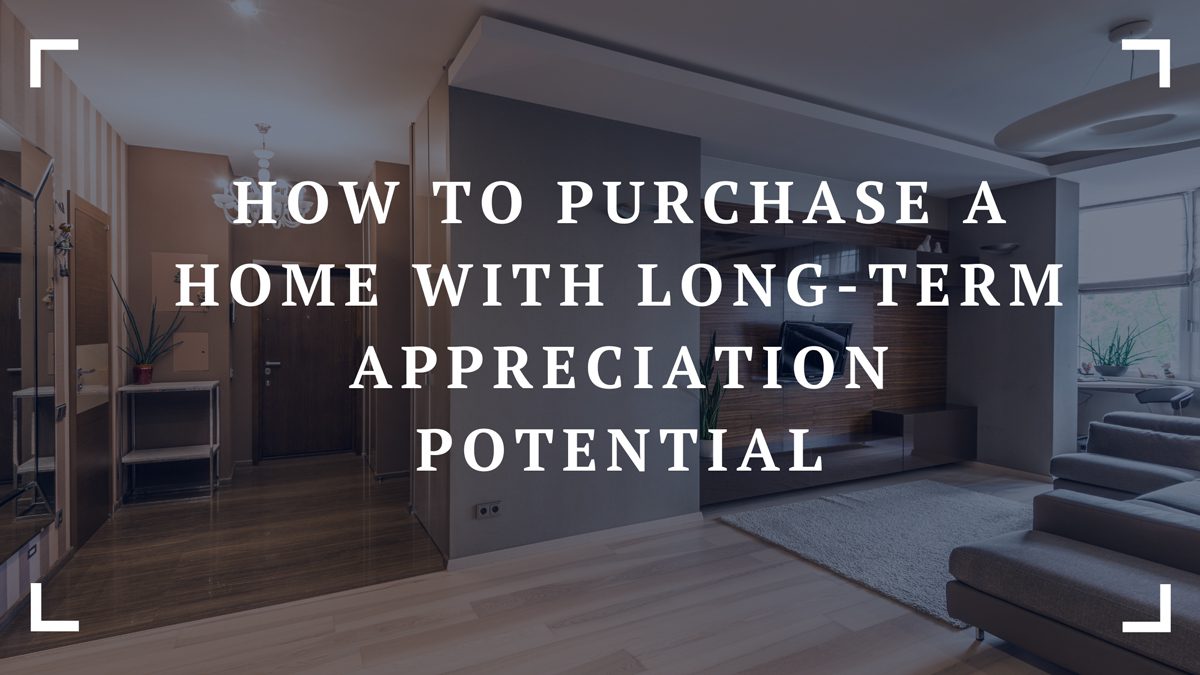Purchasing a home is big decision. Ideally, you want to purchase a home with potential for appreciation, so you can build equity for your family. Read this guide for more information on how to purchase a home with potential for appreciation.
However, please also keep your expectations realistic. While it is true that real estate investments can generate significant returns, not all properties will appreciate at the same rate. The best you can do is make informed decisions.

Understanding Long-Term Appreciation Potential
Long-term appreciation potential refers to the likelihood of a property’s value increasing over time. So, you must be wondering what impacts long-term appreciation. Well, potential for growth is influenced by various factors, such as:
- Location: Properties in desirable areas, such as those close to amenities and good schools, generally appreciate faster than properties in less desirable locations.
- Population growth: Population growth: Areas with a growing population tend to experience higher demand for housing, which can lead to increased property. For example, it may be smart right now to invest in a home in Whitby because the city is growing steadily as more people move in from bigger towns.
- Property Condition: A well-maintained property is more likely to appreciate in value than a poorly maintained one. Regular upkeep and improvements can also help.
- Property Type: Different types of properties tend to appreciate at different rates. For example, single-family homes generally appreciate faster than condominiums or townhouses.
- Government Policies: Government policies can have a big impact on real estate appreciation. For example, policies that encourage homeownership, such as tax incentives and low-interest rates, can stimulate demand for properties and lead to increased property values.
- Economic Climate: A strong economy typically leads to higher demand for properties, which in turn drives up prices. Conversely, a weak economy can result in decreased demand and lower property values. However, shortage of real estate inventory can trump any economic climate, setting property values higher.
You must also recognize that real estate is a long-term investment. Unlike stocks and bonds, property investments are not typically bought and sold quickly. Your investment in real estate will take time to bear fruit. Meanwhile, as a homebuyer, you’re saving money by not paying rent. Instead, your mortgage payments are going towards homeownership.
How to Identify Areas with High Growth Potential
Strong Economic Indicators
Areas with a diverse and growing economy are more likely to experience real estate growth. Look for regions with a low unemployment rate, a growing job market, and a diverse mix of industries.
Positive Population Trends
As mentioned, population growth can be a telling sign. Look for areas with a growing population, as this can indicate a higher demand for housing.
Improving Infrastructure
Look for properties in areas with developing infrastructure and amenities. Facilities such as schools, hospitals, and public transportation can help neighborhoods appreciate in property value. Likewise, the
Signs of Gentrification
Gentrification occurs when an area undergoes significant improvements, though some of these neighborhood changes can be controversial. For example, a coffee franchise replacing a beloved mom and pop comic bookstore is an example of gentrification. Regardless, gentrification can boost property values.
Real Estate Trends
Keep an eye on local real estate market trends. In particular, look at price fluctuations and inventory levels. These two factors can offer a strong indication of future property values.
Tips for Purchasing a Home with Long-Term Appreciation Potential
- Be patient: As mentioned, real estate appreciation is a long-term investment. To assist you in this process, consider using our Home Appreciation Calculator for a better understanding of your property’s potential. Please be patient and resist the urge to buy or sell properties quickly. In addition, take the time to research and evaluate properties before making a purchase.
- Buy in a desirable location: Again, as mentioned earlier, location is a critical factor. Look for properties in areas with strong economic indicators, good infrastructure and amenities, and a growing population. It also helps to buy in a nice neighborhood with quality residents who take care of their properties.
- Choose the right property type: Different types of properties usually appreciate at different rates. Single-family homes generally appreciate faster than condominiums or townhouses, so consider this when selecting a property. However, there can be exceptions. Consult your trusted local real estate advisor for more current information.
- Maintain and improve the property: Regularly maintaining and improving your property can help to increase its value. Ensure that you keep the property in good condition and make upgrades as needed. Of course, you also need to make the right upgrades. Consult with a property expert to ensure you’re investing your renovation money wisely.
- Stay informed: Keep an eye on real estate market trends and economic indicators to stay informed. Some factors may affect your property’s appreciation potential. For example, rising interest rates can force your property to lose value.
In conclusion, understanding the factors affecting real estate growth and appreciation is critical. By identifying areas with high growth potential, selecting the right property type, and employing strategies to maximize your investment returns, you can find certain success.


